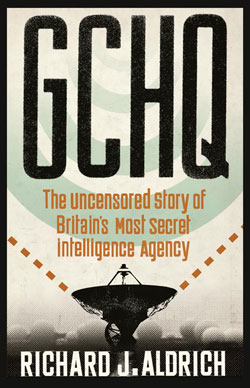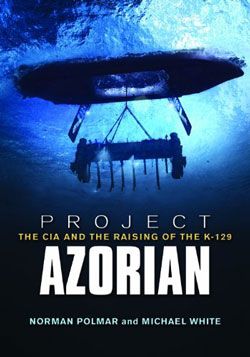 This information has been archived for reference or research purposes.
This information has been archived for reference or research purposes.
Archived Content
Information identified as archived on the Web is for reference, research or recordkeeping purposes. It has not been altered or updated after the date of archiving. Web pages that are archived on the Web are not subject to the Government of Canada Web Standards. As per the Communications Policy of the Government of Canada, you can request alternate formats on the "Contact Us" page.
Book Reviews


GCHQ: THE UNCENSORED STORY OF BRITAIN’S MOST SECRET INTELLIGENCE AGENCY, by Richard J. Aldrich and PROJECT AZORIAN: THE CIA AND THE RAISING OF THE K-129, by Norman Polmar and Michael White
by Sean M. Maloney
For more information on accessing this file, please visit our help page.
GCHQ: THE UNCENSORED STORY OF BRITAIN’S MOST SECRET INTELLIGENCE AGENCY
by Richard J. Aldrich
London: Harper Press, 2010
660 pages, (trade paperback)
PROJECT AZORIAN: THE CIA AND THE RAISING OF THE K-129
by Norman Polmar and Michael White
Annapolis, MD: Naval Institute Press, 2010
239 pages, (hardbound)
Reviewed by Sean M. Maloney
Cold War Mysteries: Two New Books
We are finally hitting our stride with the next phase of Cold War history, this time with authors who have been permitted limited access to internal classified material that remains unavailable to other researchers. Normally, this would be a problematic situation, and, during the Cold War itself, subject to substantial suspicion, depending upon one’s ideological bent. Now, with a generation of students in institutions of higher learning that, for the most part, have no real understanding nor interest in the incredibly complex machinations of ‘a war without battles,’ those carefully protected and jealously guarded secrets are virtually irrelevant, except to those of us who retain academic interest. The ideological battle is long over, and those who continue to fight it are like the Japanese soldiers holding out on Pacific islands into the 1970s.
These two books are important contributions to Cold War history. Espionage and other covert operations were a hallmark of the war, indeed, central to it in many ways. The technical nature of thermonuclear weapons-armed adversaries, and the ability or potential to virtually end life on Earth in a matter of hours, meant that an intense collection effort was a critical part of maintaining a stable deterrent system. It was not just a matter of keeping ahead of an adversary technologically - it was also critical to mask one’s own deficiencies on all fronts, and to be able to exploit the enemy’s weak spots. The difficulties in dealing with an aggressive and violent totalitarian state like the Soviet Union led the West in particular to engage in creative and even provocative behavior to gain the information it needed, in order to present the best possible deterrent posture.
Richard J. Aldrich’s tour de force GCHQ: The Uncensored Story of Britain’s Most Secret Agency is (finally) the British equivalent of James Bamford’s The Puzzle Palace. Aldrich ‘pries the lid off’ several British SIGINT (and other espionage) mysteries, and thoroughly situates them in relation to American activities. Aerial penetration operations, better known as “Ferret Flights,” were a mainstay of intelligence collection in the 1950s, and GCHQ depicts just how dangerous they were, with RAF aircraft from secret squadrons getting shot down or shot up in and around Berlin and the Baltic Sea. Another important section is a detailed discussion of Royal Navy-GCHQ cooperation involving submarine operations, including the voyage of Her Majesty’s Submarine (HMS) Turpin and her sister SIGINT collectors, and their encounters with the Soviet navy. Aldrich also sheds light on the disappearance of Lieutenant-Commander (ret’d) Lionel “Buster” Crabb, OBE, GM, a legendary former Royal Navy frogman and war hero who mysteriously went missing while conducting a hull reconnaissance of the Soviet cruiser Ordzhonikidze in 1956.
Equally important is GCHQ’s weaving of various British spy scandals into the narrative, and Aldrich’s discussion of the Venona Project and its importance in the Cold War, outside of the until-now strictly American context that exists in the literature. If there is a down side, Aldrich focuses more upon the US-UK relationship, to the detriment of Canada’s participation and cooperation with Britain in the SIGINT special relationship that existed between the English-speaking countries. That said, Canadian SIGINT personnel were aboard some British submarines during their operations. It is interesting to see how much GCHQ was involved with global monitoring of friend and foe during de-colonization in the 1950s and 1960s - and how there were security incidents in GCHQ facilities involving lesbian SIGINT operators that paralleled Canada’s problems at Canadian Forces Station (CFS) Shelburne. Equally enlightening is the section examining British SIGINT facilities in Iran and Turkey in the 1970s targeting Soviet missile testing, along with the role of SIGINT in the Falklands War of 1982.
Norman Polmar and Michael White have produced the thus-far definitive account of how the CIA, working with Howard Hughes, raised part of a sunken Soviet ballistic missile submarine from a depth of nearly two miles. Project AZORIAN: The CIA and the Raising of the K-129, is an astounding book about an astounding technical collection operation. Mistakenly called Project JENNIFER in previous accounts, this multi-million dollar effort involved a US Air Force acoustic nuclear detonation tracking system, a US Navy submarine specially modified to hover underwater and to take underwater photos, and the CIA-manned, Hughes-built Glomar Explorer, a ship equipped with a mechanical claw designed to recover the “target object” containing the remaining nuclear missile, the control room, and the forward section of the stricken submarine.
In 1974, the Glomar Explorer successfully snagged the forward portion of ballistic missile submarine K-129 and brought part of it to the surface, then transferred this into the purpose-built hull of the Glomar Explorer. Unfortunately, the missile fell out of its tube and was lost. The subsequent exploitation of the wreckage resulted in the discovery of several sets of remains, which were then buried at sea in what approximated a Soviet Navy memorial ceremony. The rest of the submarine, portions of which were radioactive, made their way, interestingly, to Area 51 in Nevada for burial after exploitation.
Polmar and White’s depiction of events is fully illustrated. This includes haunting photo mosaics of the K129 wreckage taken by USS Halibut, using a then-revolutionary (in 1968) camera sled system, and a full explanation of how the Glomar Explorer functioned. What is less clear is the decision process that funded and authorized this huge project, which was, in some ways, as technically challenging as sending a man to the moon. The cost-benefit analysis of Project AZORIAN is not addressed well in the book. It is difficult to conclude that the primary objectives of the mission were accomplished, especially the loss of the missile and its nuclear warhead. Exploitation of that system, which had been superseded in 1967 by the missiles carried by the Soviet Yankee-Class ballistic missile submarines, would have ‘filled in some blanks’ with respect to the 1958-1961period. It would not, however, have provided much useful information on the Soviet nuclear arsenal circa 1969-1974.
As a Cold War historian, I strongly recommend both works. They are both well-written, they are accessible to an audience not au fait with the Cold War, and they both serve to undermine decades of speculation. This is particularly true with respect to Project AZORIAN, where Polmar takes great pains to challenge theories advanced in the past three years as to the relationship between the loss of K-129 and the loss of the American submarine USS Scorpion. Bravo Zulu to all three authors.
![]()
Sean M. Maloney, PhD, is a well-established military historian and author. He is also an Associate Professor of History at the Royal Military College of Canada.






